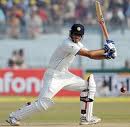 Rahul Dravid’s nickname the The Wall, is a wonderful analogy for his ability to bat for long periods and withstand pressure.
Rahul Dravid’s nickname the The Wall, is a wonderful analogy for his ability to bat for long periods and withstand pressure.
The image he conjures for me is the ‘The Iceman’, he is incredibly cool under pressure, there is an almost surgical like precison to his batting.
Dravid is cricket’s version of Bjorn Borg, the great Swedish Tennis player, the C words start to back up on themselves; Cool, Calm, Consistent, Clinical, Confident, Concentrated.
His performances will be recorded in cricket history as one of the greatest batters of all time.
And yet there is more to Rahul Dravid than this, the fact that so many Indian batters have scored large amounts of their runs on flat subcontinent batting wickets isn’t an issue for Dravid, his game has travelled overseas and he has done it against the best.
His Test record overseas is in fact better than it is at home.
Dravid was, with Tendulkar, the batting spine of a side that for so long had limited bowling fire power.
This is critical for batters, so many ‘great’ batters have been able to go and score their runs off the back of a bowling attack that could bully the opposition, or at the very least control the game.
Think West Indies of the 80’s to mid 90’s and Australia of the mid 90’s and 00’s .
It gives a measure of confidence to batters, there were none of these securities for Dravid though.
India under John Wright as Coach and Sourav Ganguly as Captain, began to play as if they had some real steel. This was reflected in the attitude of its main batters, Dravid being one of these.
Amongst all of this he has managed to retain his humility and dignity, almost as if he is unaware of the magnitude of his batting exploits.
There is no ‘ego’ looking over the shoulder at Tendulkar, wondering why India is so obsessed with him.
He is secure and seemingly at peace with himself.
Rahul Dravid is the product of a middle class Indian home, not privileged, his journey is a reflection of a steely focus.
In India there are no short cuts as a batter into the Indian side, if you can’t cut it, you will get found out, sooner rather than later.
The Mental Game, strength, conditioning and cricket technique will be tested, it is a hard school.
 The Cricket Mental Game
The Cricket Mental Game
One thing that is reflected in performance is focus, no focus, no performance.
There are lots of theories in sports psychology andmental toughness about what performance is really about, it ultimately boils down to holding your attention, your focus, on your goal long enough to able to roll out your game plan and complete it.
Rahul Dravid is one of crickets’ masters in this field, this and his ability to freeze out pressure.
The two go together of course, to focus, the batter most hold and manage his attention, all the while continuing to play with positive intent.
To work through the cycles of attention that are required for long, endurance innings, requires the ability to tune out everything but the ball, over and over again.
Fear and anxiety create mental distractions, these thoughts manifest as ‘pressure’, the mind starts to wander and batters lose their game planand their technique.
Not only this, the batter fatigues faster, the best laid foundations start to crumble and what looks like a promising start, both to an innings and a career, falls away as they find they can’t cope.
And yet there is Rahul Dravid, the man whose method and focus is so strong, that the fear and anxiety that choke others is grist to his mill.
After his herculean innings at Adelaide against Australia in 2003-2004, which is perhaps his defining innings, he is quoted as saying he thinks there is more to come, that he is still looking forward to getting better.
In the Japanese faith of Zen Buddhism, they speak of ‘beginners mind’, that those who are enlightened understand that one must look at the world as a young child does, that there is still much to learn.
Dravid would make a wonderful Zen Master.
His batting method is reflected in his specificity of practice.
The old adage of practicing like you play is not just a glib quote for Dravid, it is central to his game plan.
Practice, nets and batting technical work are opportunities to specifically groove his game, to hone method and make it right for match time.
Wayward shot selection and getting out in the nets is not okay for Dravid.
His mental game is a model for younger players
 Rahul Dravid Mental Game Plan
Rahul Dravid Mental Game Plan
Rahul Dravid practices as much as he can going into a match, to have lots of nets, he wants the flow of his batting, the focus, weight transfer and feel of the stroke to be right.
The batting technique and ‘feel’ have to get to a point where he is confident that they are where he wants them to be, then he puts that down and moves on to his mental game.
As he says in an interview post Adelaide, when asked of his batting preparation,
‘I look at the wicket. I try to analyse the kind of bowlers I will be playing, their strengths and weaknesses. I replay in my mind the memories of my last encounter with them. I look at videos if they’re available. If a bowler got me out the last time, I try to think about how I got out, what mistake I committed.’
You can see the strategy, the goal and the information gathering to make sure that he plans his innings accordingly.
There are no accidents in Dravids success.
To go back to the section on cricket strategy on the website, I make reference to the fact that winning begins off field, in the design of the game plan. You can see the Dravid Method.
He consciously slows things down as he gets closer to the match, trusting his preparation, focusing on relaxation to get the right mood .
Of visualization he says this, the night before a game he will spend 15 minutes running through the next day, clarifying his thoughts and what he wants to make happen.

Batting Technique
To develop a batting technique that will hold up in all the conditions found in the cricketing world takes much thought and work.
Sorting out the flaws in your game and then working on them enough so that the right batting techniquegets laid down in the subconscious mind, that the batter no longer has to think about them, this is key.
There are no short cuts with this, it is to hit enough balls so that it is polished and technique runs on automatic.
When this is done then the left brain can quieten down and hand over to the right brain where the motor skills for batting reside.
Stillness is a Rahul Dravid signature at the crease, the product of a quiet mind, no extraneous movements, no wasting of valuable energy, like all the greats there is this quietness expressed in his game.
It is a superbly trained brain and focused mind.
The quietness and stillness are reflected in the stroke production, the Dravid stance is orthodox, classically side ways on, head inclined and set slightly forward in the stance.
Good strong posture and presence, the strokes come from a base of excellent footwork, a short powerful bat swing and clear decision making.
As you can see in the Dravid strokes on this page, the movements are precise, no flamboyant twirls, just crisp simplicity, like his team mate Tendulkar.
Each stroke a thing of beauty.
The Key Dravid strokes are the front foot drives, cuts and pulls.
It is unusual for an Indian batter to be so adept on the back foot, Dravid puts this down to playing on matting as a youngster and a conscious goal to develop this so that he can take his game out of the subcontinent and excel.
Superb weight transfer, exemplified in these photos, is one of the cores of his game, with the head completely commited to the stroke the body weight is out and over the ball.
This allows the arms and angle of the bat on contact to be over the ball, with a hitting down on the ball motion, allowing for greater control and placement.
Strength and Conditioning
A piece on Rahul Dravid would not be complete without making mention of physical conditioning.
The consumate professional, no aspect of the complete performance picture is ignored, Rahul has worked incredibly hard on his conditioning to be in shape to bat such long periods of time.
He acknowledged in 2004 the work of the Indian conditioning coach Greg King in his monumental Adelaide knock.
He understands the mind-body connection, the mind cannot be strong without a body that is well conditioned, you can’t focus if you are physically exhausted.
As Dravid says of reaching his Zone State,, the fitter you are, the better your chances of reaching it.
From Rahul Dravid Back To Cricket Players
Back To MyCricketGame.Com

About Richard Pybus
I'm Richard Pybus, I've coached Pakistan, Bangladesh, Middlesex, Titans and the Cape Cobras in South Africa and the goal of this site is to help you to play winning cricket.
